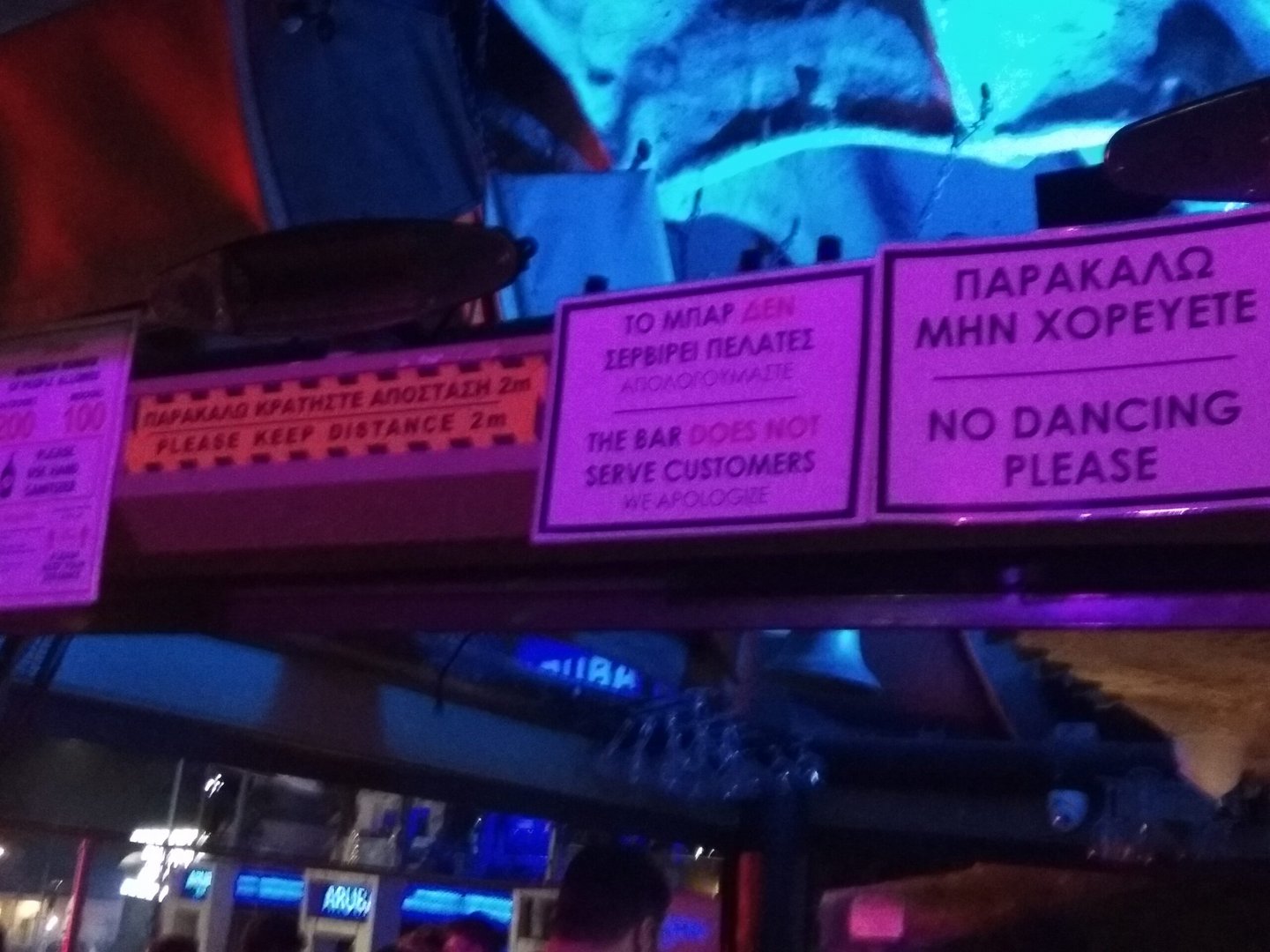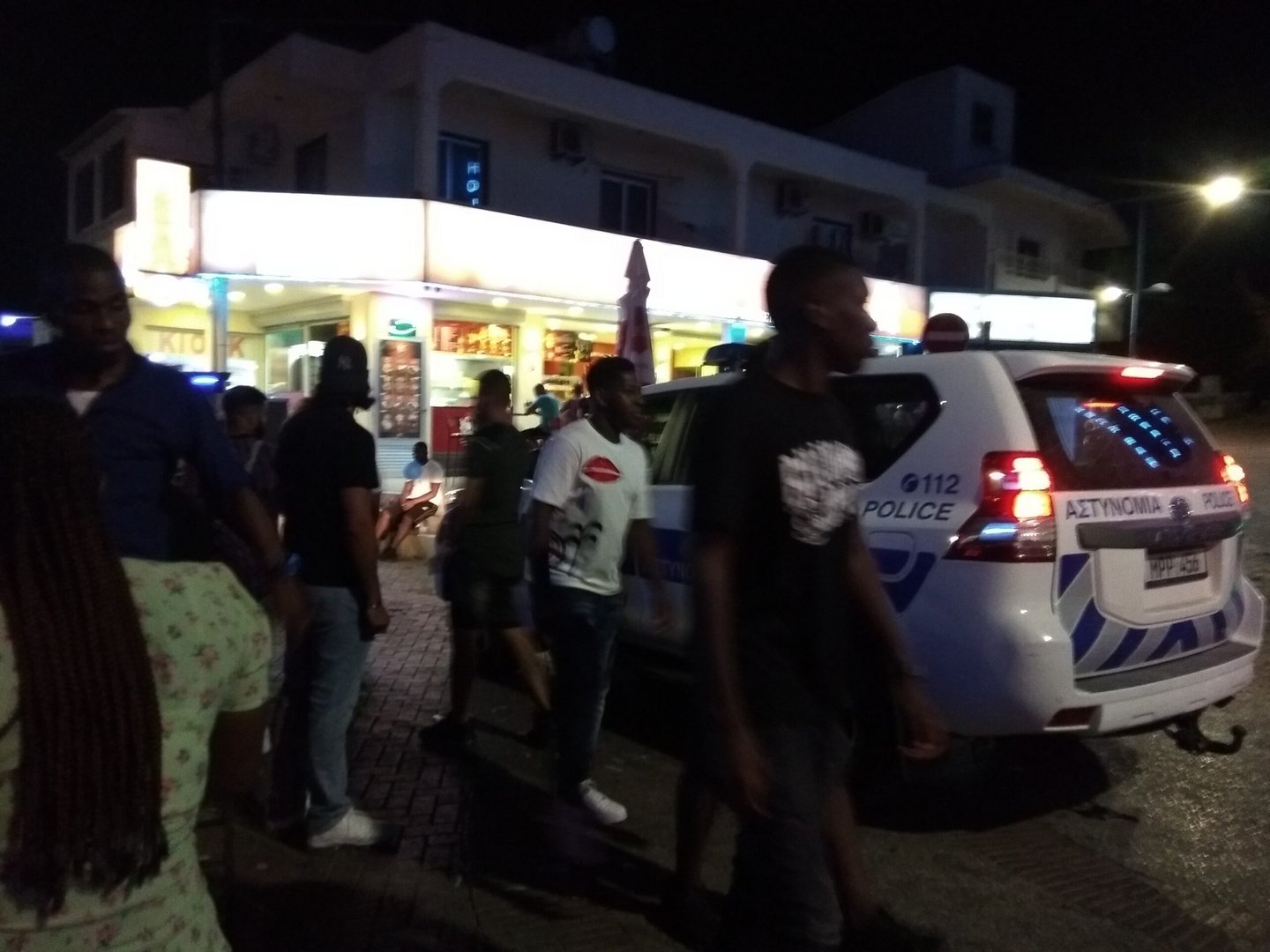Cyprus Mail 8 August 2021 - by Nick Theodoulou
 |
| Ayia Napa's busy central square last Saturday night |
Not many Brits, but Ayia Napa has reclaimed some of its pre-pandemic bustle
By Nick Theodoulou
In the summer of 2021 Ayia Napa is back on its feet and has regained some of its pre-pandemic swagger as thousands flock there to bask in the sun and leave the lonely lockdowns behind.
Driving into a lively Ayia Napa this summer was a far cry from the depressing setting of last year, when many businesses remained closed. This time around, the tourists are back, well, sort of.
On the face of it, Ayia Napa looks the same: exaggerated themed restaurants and bars – the sandy blue beaches aren’t going anywhere either – but there are major differences.
It’s all about the people: So who came over and why?
On a sweltering and humid Saturday evening I met 19-year-old Nicole from Limerick, Ireland – who is currently working at an Irish themed bar near the party-centric main square.
“I first came over for a month-long holiday, but I partied a bit too much and spent my money, so now I’m working along with my friend,” she told the Sunday Mail.
“Ireland had some very strict lockdowns, so it was great to come here and have the freedom,” Nicole said.
But why did Nicole and her friend choose Ayia Napa over, say, Magaluf or Ibiza?
“Everyone goes there, the rest of our friends did, but we wanted something different,” she said.
It was around 10pm and the bar – complete with false wooden beams and a thatched roof, imitating traditional architecture back in Ireland – was quiet. Not many of her Irish compatriots travelled over this year.
A talented young man performed some hits on his guitar, but it seemed that the rowdy nightlife which is synonymous with Ayia Napa had somehow evaporated.
We were on one of the main arteries connecting the bustling square with the beachfront, which in previous years – at this time of the night – one would witness groups of young ‘lads’ stumbling about, whooping and hollering.
Walking along the road towards the square, lined with tattoo parlours, kiosks and some bars, there were even a few families with young children wandering through.
The party street did gradually fill up but noticeably absent were the Brits – the English in particular – who are usually the main market for Ayia Napa.
We did meet some though, such as Max, 25, from England who is now into his third year of working in Ayia Napa.
“I’ve moved out here full time now whereas before I’d come and do seasons [working during the summer months], I’ve spent two lockdowns here, but I love it in Napa,” he told the Sunday Mail.
“I did the first season when I was 22 – I’m 25 now – if you like to socialise, if you like to party but manage to find a good balance of it then it’s brilliant… then I decided, you know what I’ll stay here,” Max said.
What’s the biggest difference between pre-pandemic and now?
“Well obviously the businesses. We thrive off tourism numbers – it’s still busy now – but there’s a lot of countries whose tourism companies aren’t flying them out here,” he said.
“We’ve got a lot of Russians, Cypriots, Swiss, Danish, a lot more Scandinavians, we’re about three times as busy as last year although it’s still not back to how it was… but usually the bread and butter were the English, Russians and some Israelis,” he said.
“It’s not as busy but you’re still getting groups of young 18-19-year-olds from Denmark, Norway and all those places,” he said.
It was a struggle to hear Max clearly over the blaring music in the middle of the street, and it was time anyway to check out one of the busy bars.
This one had a prehistoric-dinosaur theme to it, but all the focus was on a group of nine men dancing their hearts out, pumping their fists in the air and knocking back bottles of Keo beer.
They told me they were students from Pakistan but live in downtown Nicosia, now enjoying a night out in Ayia Napa where they were to stay the night.
“Είναι όλα καλά, φίλε [It’s all good, friend],” the merriest of the bunch told me with a beaming smile.
It was refreshing to see people enjoying themselves freely, but back at my table – with a view of the bar – a sign stood out: “NO DANCING PLEASE”.
Oh yeah – the pandemic.
With all the fuss and commotion, it almost slips one’s mind that there’s an ongoing pandemic, with decrees in Cyprus currently dictating that dancing is banned (except in venues hosting only the fully vaccinated or recently recovered), masks must be worn outside and a SafePass is required to enter businesses with more than ten people.
To be sure, the staff at the bars were wearing masks but other than that it’s as if the pandemic is over, or at least the regulations.

Asked about this, Ayia Napa mayor Christos Zannettou told the Sunday Mail that the vast majority of businesses are complying with the regulations. He was speaking before Nava club in nearby Protaras was closed on Friday night for allowing dancing and over 1,000 people inside.
“There may be isolated incidents, but we are not able to monitor everything, but it’s also the remit of the police who are working on this and there have been many fines issued to those violating the measures,” he said.
Fair enough, but for the more Covid-conscious the sight of sweaty dancers freely mixing and mingling may cause fearful outrage.
But, the next day there was no sign of concern amongst the dozens of families and young couples back at the beachfront Melissi hotel, who were relaxing in the sun by the swimming pool.
It was a late night, being up until about 4am and I missed breakfast, but a quick dip in the pool did the trick.
It was comforting seeing life return to Ayia Napa: paragliders marking the blue skyline, busy beaches and sun-seeking tourists getting a tan before heading home to colder climates.
And while the more boisterous young-uns tend to steal the show, young couples and family holidaymakers are quietly setting the scene – with the market seemingly adapting to their tastes.
Fancy restaurants and cafes are increasingly finding a home in Ayia Napa, as are alternative forms of entertainment such as up-market shisha bars.
So are sushi and salads encroaching on the previously staked out territory of burgers and chips?
“This year is certainly pointing towards an increase in families and couples visiting who are not after the nightlife but are seeking rest and relaxation,” the mayor told the Sunday Mail.
“There has been an important increase in quality restaurants, which have always existed, but now it’s looking like the people are getting to know them better,” Zannettou said.
He said that the increase in local tourism and trends from the pandemic have seen a shift towards many businesses focusing on quality.
One reason offered as to the shift in clientele is that those who are able to afford a trip abroad during the pandemic are typically older with more money to spend.
“Ayia Napa is about 40 per cent as busy as it was in 2019 [a record year] but local tourism is incredibly important as it plays a major role, especially on the weekends, in the recovery from the pandemic for Ayia Napa,” Zannettou said.
The motto “what happens in Napa stays in Napa” – you’ll find tank-tops with the slogan in shops – certainly still rings true.
But it definitely has shrugged off some of the sleaze it was known for, gradually becoming a more family friendly destination.
Transformed from a sleepy fishing village as recently as 1977, Ayia Napa has proved itself versatile.
With a stated vision in 2018 to become “the best and most cosmopolitan tourist resort of the Mediterranean by 2030”, there’s a lot riding on the success of its new projects – such as the underwater museum which opened last week.
But the path towards that goal led off a cliff once the pandemic hit.
Just two years ago Ayia Napa was eager to wean itself off the boozy teens, who are typically seeking cheap deals and spend less than a middle-class family – along with creating the perfect storm for alcohol induced PR scandals – but the tourism industry then found itself desperate for any tourists at all.
It may take some time yet to disentangle itself from the Dionysian delights with which it is still often associated, but it is certainly making strides towards that goal.

